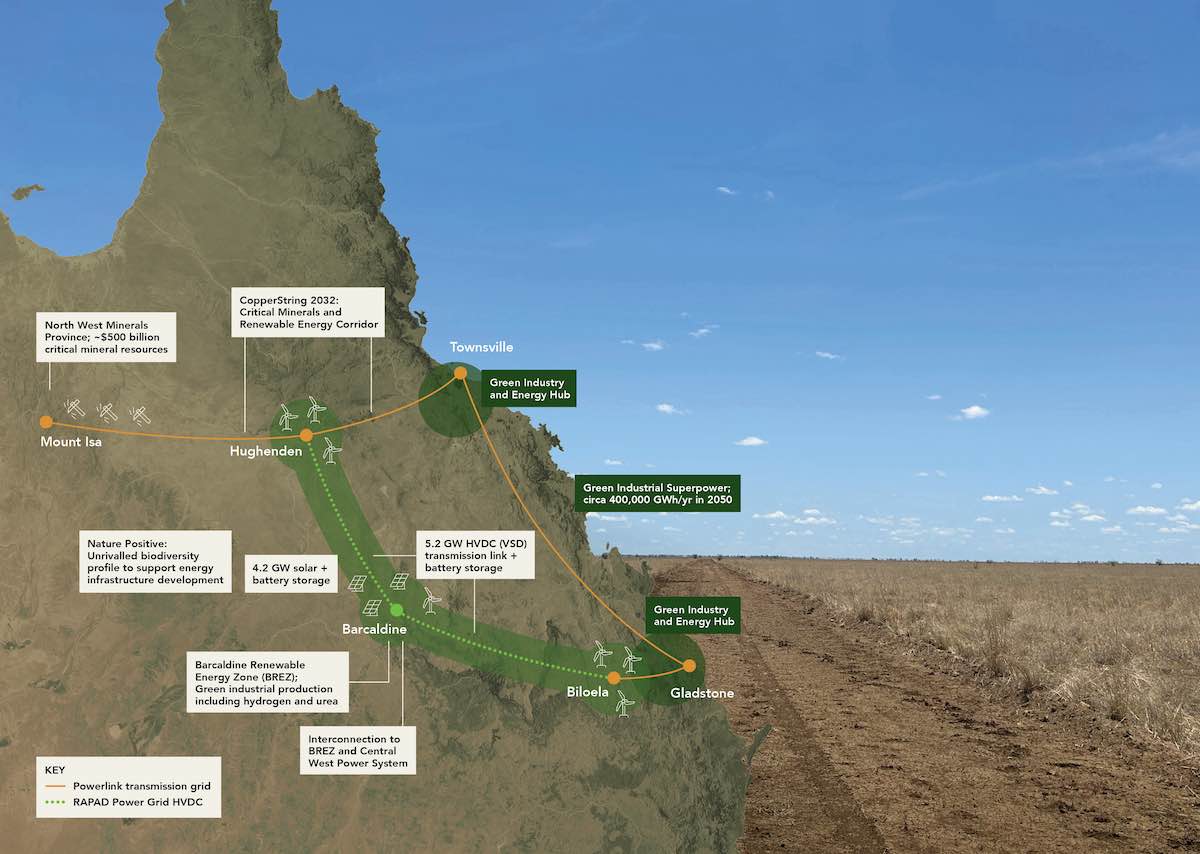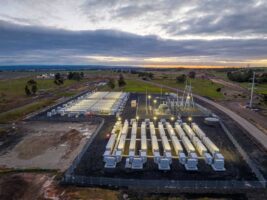Seven regional Queensland councils have joined forces with the founders of the CopperString transmission project to develop a new 930km “clean energy corridor” in the state’s north, featuring 4.2 gigawatts of solar, grid-scale battery storage and a high voltage transmission line linking Hughenden to Biloela, via Barcaldine.
The huge plans were outlined in a memorandum of understanding announced late on Monday by the Central Western Queensland Remote Area Planning and Development (RAPAD) Board, the Barcaldine Regional Council (BRC) and Townsville-based VisIR.
Visir is the parent company to CuString, which originally developed the $5 billion CopperString transmission project – the 1,100km link spanning the Townsville to Mount Isa corridor and connecting north Queensland to the state’s renewable SuperGrid.
State-owned transmission company Powerlink took ownership of CopperString in March 2023, with the Palaszczuk government recently announcing it will spend $1.3 billion to get the transmission project to shovel-ready status in mid-2024.
The newly announced plans for the RAPAD Power Grid would install a “non-regulated line” – supported by commercial contracts with major network users .
The idea is to link the Townsville to Mount Isa CopperString corridor at Hughenden through the central west and into the industrial and energy centre in Biloela, near Gladstone.
Along the corridor of the new high voltage, direct current (HVDC) cable, a 4.2GW of solar would be installed (see map above) – a huge array that RAPAD says can be accommodated easily by the existing “vast open spaces” in the region.
The group says the new transmission line will be accessible to third party renewable energy projects in the region, and able to host 5.2GW of capacity, while “common-user battery storage” will also be integrated with the network.
As was the case with CopperString, the idea behind the Rapad Power Grid is to help power power north Queensland’s green industrial and hydrogen export ambitions, particularly in Gladstone and Townsville, by bridging transmission gaps and boosting the region’s capacity to host new renewables.
The new transmission lines, solar and storage will also help the state to usher out its ageing coal-fired generation fleet, including the Callide black coal power station, in Biloela.
The involvement of the councils in the new project is an interesting development, at a time when the urgent build-out of major new transmission corridors across Australia is scrambling to gain social license.
“We understand the social licence for renewable energy projects is a massive challenge in other regions said Rapad chair and Longreach Regional Council mayor Tony Rayner.
“We believe a community-led approach, locating transmission lines and other projects where the vast open spaces and environment can facilitate such development will be successful and be great for our region and for Queensland.
Rayner says the central west has “an unrivalled capacity” to produce and export clean energy and green industrial products.
“With the government’s commitment to deliver CopperString 2032 coming online as part of the Energy and Jobs Plan, and Gladstone and Townsville emerging as green industrial hubs it seems our region might hold the key to Queensland becoming a clean energy superpower,” Rayner said on Monday.
“We want to ensure we take that opportunity to strengthen our local economy, creating new jobs and complementing our economic mainstays of agriculture and tourism.”
One of the group’s key selling points is that the region that would host the new transmission line offers up to 12GW of “world class” solar and wind resources that can be developed “without competition for agricultural production or damage to nature.”
Barcaldine mayor Sean Dillon says the group has already had “initial and constructive discussions” about the on the Rapad Power Grid development with landholders, and indigenous First Nations custodian representatives.
“Out west, we see the risks of developing energy infrastructure in other regions that are more densely populated, with more intensive agriculture, more vegetation to clear, and lower quality energy resources, and we believe this creates a big economic opportunity for our region that we want to capture,” Dillon says.
“We only need to utilise 0.06% of the Rapad area to produce over 4,000 megawatts of solar, and probably won’t need to cut down a single tree.”.
VisIR founder Joseph O’Brien says the Rapad Power Grid has been led by the community and presents a unique opportunity to build on the state government’s renewable energy plans.
“Western Queensland holds the key to nature positive clean energy development and our partnership with the central west communities is a unique and powerful model that we are grateful to be part of,” O’Brien said.










